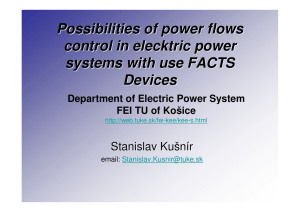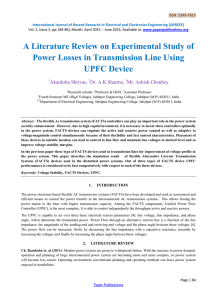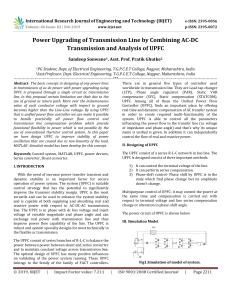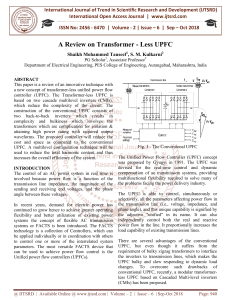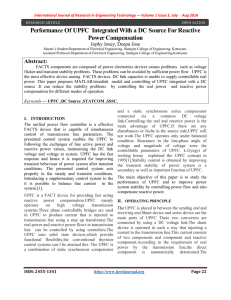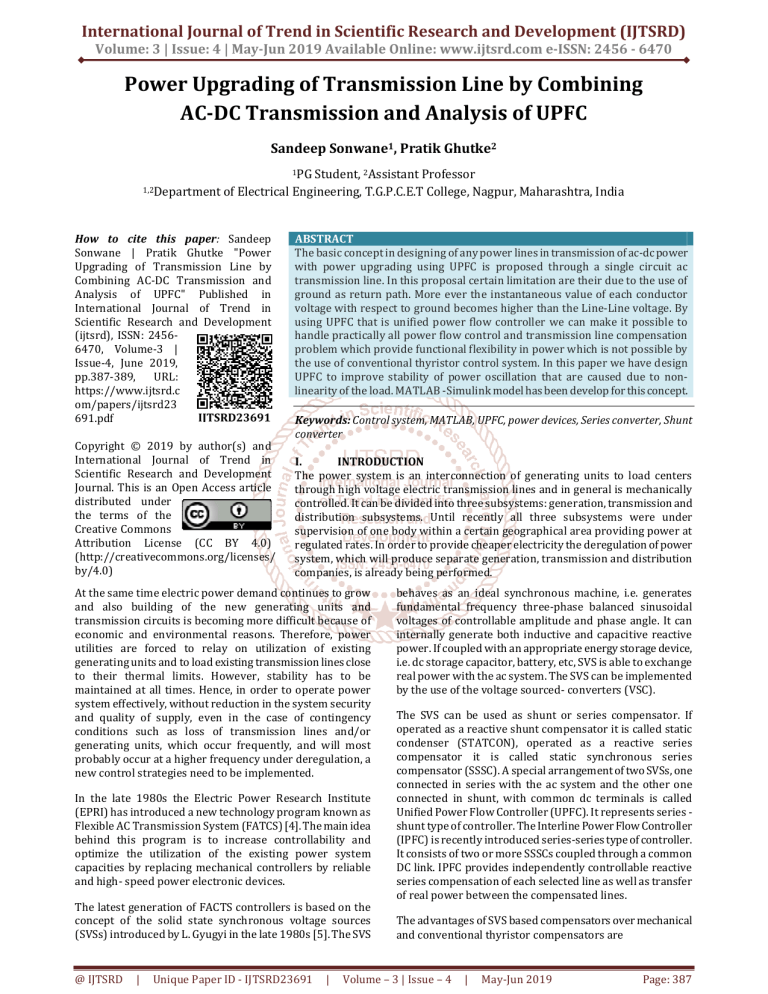
International Journal of Trend in Scientific Research and Development (IJTSRD)
Volume: 3 | Issue: 4 | May-Jun 2019 Available Online: www.ijtsrd.com e-ISSN: 2456 - 6470
Power Upgrading of Transmission Line by Combining
AC-DC Transmission and Analysis of UPFC
Sandeep Sonwane1, Pratik Ghutke2
1PG
Student, 2Assistant Professor
1,2Department of Electrical Engineering, T.G.P.C.E.T College, Nagpur, Maharashtra, India
How to cite this paper: Sandeep
Sonwane | Pratik Ghutke "Power
Upgrading of Transmission Line by
Combining AC-DC Transmission and
Analysis of UPFC" Published in
International Journal of Trend in
Scientific Research and Development
(ijtsrd), ISSN: 24566470, Volume-3 |
Issue-4, June 2019,
pp.387-389,
URL:
https://www.ijtsrd.c
om/papers/ijtsrd23
IJTSRD23691
691.pdf
Copyright © 2019 by author(s) and
International Journal of Trend in
Scientific Research and Development
Journal. This is an Open Access article
distributed under
the terms of the
Creative Commons
Attribution License (CC BY 4.0)
(http://creativecommons.org/licenses/
by/4.0)
ABSTRACT
The basic concept in designing of any power lines in transmission of ac-dc power
with power upgrading using UPFC is proposed through a single circuit ac
transmission line. In this proposal certain limitation are their due to the use of
ground as return path. More ever the instantaneous value of each conductor
voltage with respect to ground becomes higher than the Line-Line voltage. By
using UPFC that is unified power flow controller we can make it possible to
handle practically all power flow control and transmission line compensation
problem which provide functional flexibility in power which is not possible by
the use of conventional thyristor control system. In this paper we have design
UPFC to improve stability of power oscillation that are caused due to nonlinearity of the load. MATLAB -Simulink model has been develop for this concept.
Keywords: Control system, MATLAB, UPFC, power devices, Series converter, Shunt
converter
I.
INTRODUCTION
The power system is an interconnection of generating units to load centers
through high voltage electric transmission lines and in general is mechanically
controlled. It can be divided into three subsystems: generation, transmission and
distribution subsystems. Until recently all three subsystems were under
supervision of one body within a certain geographical area providing power at
regulated rates. In order to provide cheaper electricity the deregulation of power
system, which will produce separate generation, transmission and distribution
companies, is already being performed.
At the same time electric power demand continues to grow
and also building of the new generating units and
transmission circuits is becoming more difficult because of
economic and environmental reasons. Therefore, power
utilities are forced to relay on utilization of existing
generating units and to load existing transmission lines close
to their thermal limits. However, stability has to be
maintained at all times. Hence, in order to operate power
system effectively, without reduction in the system security
and quality of supply, even in the case of contingency
conditions such as loss of transmission lines and/or
generating units, which occur frequently, and will most
probably occur at a higher frequency under deregulation, a
new control strategies need to be implemented.
In the late 1980s the Electric Power Research Institute
(EPRI) has introduced a new technology program known as
Flexible AC Transmission System (FATCS) [4]. The main idea
behind this program is to increase controllability and
optimize the utilization of the existing power system
capacities by replacing mechanical controllers by reliable
and high- speed power electronic devices.
The latest generation of FACTS controllers is based on the
concept of the solid state synchronous voltage sources
(SVSs) introduced by L. Gyugyi in the late 1980s [5]. The SVS
@ IJTSRD
|
Unique Paper ID - IJTSRD23691
|
behaves as an ideal synchronous machine, i.e. generates
fundamental frequency three-phase balanced sinusoidal
voltages of controllable amplitude and phase angle. It can
internally generate both inductive and capacitive reactive
power. If coupled with an appropriate energy storage device,
i.e. dc storage capacitor, battery, etc, SVS is able to exchange
real power with the ac system. The SVS can be implemented
by the use of the voltage sourced- converters (VSC).
The SVS can be used as shunt or series compensator. If
operated as a reactive shunt compensator it is called static
condenser (STATCON), operated as a reactive series
compensator it is called static synchronous series
compensator (SSSC). A special arrangement of two SVSs, one
connected in series with the ac system and the other one
connected in shunt, with common dc terminals is called
Unified Power Flow Controller (UPFC). It represents series shunt type of controller. The Interline Power Flow Controller
(IPFC) is recently introduced series-series type of controller.
It consists of two or more SSSCs coupled through a common
DC link. IPFC provides independently controllable reactive
series compensation of each selected line as well as transfer
of real power between the compensated lines.
The advantages of SVS based compensators over mechanical
and conventional thyristor compensators are
Volume – 3 | Issue – 4
|
May-Jun 2019
Page: 387
International Journal of Trend in Scientific Research and Development (IJTSRD) @ www.ijtsrd.com eISSN: 2456-6470
improved operating and performance characteristics
uniform use of same power electronic device in different
compensation and control applications
Reduced equipment size and installation labor.
II.
Scope of Present Work
Using the concept of the control system a power system
is taken to implement the use of UPFC. The two modes
i.e. the power flow control and the voltage injection
mode are simulated in SIMULINK to see the effect of
UPFC on a power system. Study is carried out to verify
the utility of FACT device.
Its application study the steady-state and dynamic
performance of a unified power flow controller (UPFC)
used to relieve power congestion in a transmission
system.
The load flow analysis and the single line diagram
simulation are done on power flow simulator.
This software(MATLAB) helps to calculate the power
flow, the voltage at each bus and the cost effectiveness of
the system. Based on test power system.
The Optimal Power Flow Analysis (OPF) has been
implemented for various case studies. This case is
considered in order to investigate the effect of Test
power system absence of UPFC in comparison with
presence of UPFC in OPF.
3.
Phase-shift control- Phase shift by UPFC is in the state
which finds phase change but its amplitude doesn’t
change.
Multipurpose control of UPFC; it may control the power at
the same time and compensation is carried out with respect
to terminal voltage and line series compensation change or
alteration in phase-shift angle.
The power circuit of UPFC is shown below
Fig1. Basic power circuit of UPFC
V.
Simulation Model
In this project, I am going to monitor the power of the
system especially known as industries and controlling the
power line using power factor. Here the current
transformers and potential transformers are widely used for
analyzing the performance of the power and it is given to the
circuit .It is known that electricity comes in our home is not
stable in nature.
There are many fluctuations, raise and falls, and spikes in
this current. This unstable current may damage instruments.
The fluctuating current wastes the electric current in the
form of heat energy. This heat energy not only gets wasted to
the atmosphere, but also harms the appliances and wiring
circuit.
Fig2.Simulation of model of system
VI.
Simulation Model of UPFC
III.
Aim and Objectives
In power system transmission, it is desirable to maintain the
voltage magnitude, phase angle and line impedance.
Therefore, to control the power from one end to another
end, this concept of power flow control and voltage injection
is applied .Modeling the system and studying the results
have given an indication that UPFC are very useful when it
comes to organize and maintain power system.
In this study the effects of UPFC locations are investigated on
voltage profile and transmission lines power flow as active
and reactive power are analyzed.
Fig3.Simulation model of UPFC
VII.
Results
Following Objectives are made:
1. Power flow control to be achieved and congestion
Should be less
2. Transient stability Should be improved
3. Faster Steady State achievement
4. Improved Voltage Profile
IV.
Designing of UPFC
The UPFC consist of a series R-L-C network in bus line. The
UPFC is designed consist of three important methods.
1. It can control the terminal voltage of the line.
2. It can perform series compensation.
@ IJTSRD
|
Unique Paper ID - IJTSRD23691
|
Volume – 3 | Issue – 4
Fig4. Result of thyristers.
|
May-Jun 2019
Page: 388
International Journal of Trend in Scientific Research and Development (IJTSRD) @ www.ijtsrd.com eISSN: 2456-6470
VIII.
Conclusion
The purpose of applying FACTs tools is to removes the
oscillation of the power angle and increase stability of the
system by upgrading the power more-ever the UPFC helps in
providing the quality power without damping and
controlling the voltage effectively at the non-linear load side.
UPFC is one of the index tools of AC transfer system having
promising capabilities for controlling the parameters of
utilizing the transfer system in the steady state and the
transient state of system.
IX.
Future scope
This work deals with modeling and simulation of 30 bus
system using MATLAB simulink..
This work has covered power quality in 30 bus system
using UPFC.
The work may be extended to sixty four bus system.
Hardware implementation is beyond the scope of this
work.
Laboratory model for the hardware may be
implemented using Digital Signal Processor (DSP).
114 Multibus system with multiple FACTS controllers
may be studied to observe the power quality
improvement.
Closed loop system using Neural network or genetic
algorithm can be studied in future.
Research and development is a non-stopping process. For
any research work carried out, there is always a possibility
for better chances of improvement and lot many avenues
opened for further work.
As a result of the investigations carried out in the area of
power system stability improvement with FACTS controllers,
following aspects are identified for further scope of research
work.
1. The present work can be extended to power system
with generalized TCSC, UPFC and Interline Power Flow
Controller (IPFC).
2. The system investigated has been limited up to a threemachine power system. It would be desirable to extend
the proposed approach for larger and more realistic
systems.
3. The present work can be extended for STATCOM and
SSSC with energy storage such as battery Energy Storage
System (BESS) and Superconducting Magnetic Storage
(SMSS) for enhancing power system stability.
4. The present work can be extended for damping of
torsional oscillations.
5. Stability issues for a distribution network with different
types of distributed generation sources and FACTS
devices could be examined and FACTS-based controllers
could be designed for improving the stability in
presence of different types of distributed generations.
@ IJTSRD
|
Unique Paper ID - IJTSRD23691
|
6.
Different strategies could be tested and implemented in
an attempt to achieve a less time consuming process and
gain better understanding of heuristic optimization
techniques applicability to various power system
phenomena.
X.
References
[1] L. Gyugyi, C.D. Schauder, S.I. Williams, T.R. Reitman,
D.R.Torgerson and A. Edris, 1995, “The Unified Power
Flow Controller:A new approach to power
transmission control”, IEEE Trans. On Power Delivery,
10(2), pp. 1085-1095.
[2] M. Noroozian, L. Angquist, M. Ghandhari, G. Andersson,
1997, “Use ofUPFC for Optimal Power Flow
Control,”IEEE Transactions on Power Delivery 12(4),
pp. 1629-1634.
[3] B.A. Renz, A. Keri, A.S. Mehraben, C. Schauder, E. Stacey,
I.Kovalsky, L. Gyugyi, and A. Edris, 1999, “AEP Unified
Power Flow Controller Performance”, IEEE Trans. o
Power Delivery, 14(4), pp.1374-1381.
[4] L.Gyugi, Unified power flow controller concept for
flexible ACtransmission systems, IEE Proceedings-C,
Vol.139, No.4, July 1992,pp. 323-331.
[5] K.S. Verma,, S.N. Singh, H.O. Gupta, Location of unified
power flowcontroller for congestion management,
Electric Power Systems Research 58 (2001) 89-96.
[6] M. Noroozian, L. Angquist, M. Ghandhari, G. Andersson,
1997, “Use of UPFC for Optimal Power Flow Control,”
IEEE Transactions on Power Delivery, 12(4), pp. 16291634.
[7] D. Murali, Dr. M. Rajaram, Active and Reactive Power
Flow Controlusing FACTS Devices, International
Journal Of ComputerApplications (0975 – 8887),
Volume 9 – No.8, November 2010.
[8] S. Tara Kalyani, G. Tulasiram Das, Simulation of Real
and ReactivePower Flow Control with UPFC Connected
to a Transmission Line, International Journal Of
Computer Applications, 2008, (16-22)
[9] Xiao-Ping Zhang,Christian Rehtouz, Bikash Pal, Flexible
AC Transmission Systems: Modeling and Control,
Springer-Verlag Berlin Heidelberg, 2006.Papers from
Conference Proceedings (Published)
[10] Bhanu
CHENNAPRAGADA
Venkata
Krishna,
KOTAMARTI. S. B.Sankar, PINDIPROLU. V. Haranath,
“17th International Conference on Electricity
Distribution,” CIRED, Barcelona 2003, Session 5 Paper
No 19.
Volume – 3 | Issue – 4
|
May-Jun 2019
Page: 389


